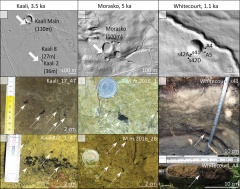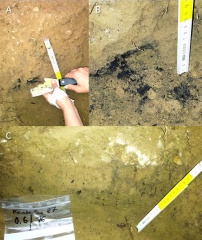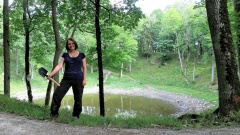(Unless otherwise stated, the copyright of the materials included belong to Jan Woreczko & Wadi.)
Szablon:Łosiak (2022)
Z Wiki.Meteoritica.pl
Łosiak Anna[1], Belcher Claire M., Plado Jüri, Jõeleht Argo, Herd Chris D.K., Kofman Randy S., Szokaluk Monika, Szczuciński Witold, Muszyński Andrzej, Wild Eva M., Baker S.J., (2022), Small impact cratering processes produce distinctive charcoal assemblages, Geology, 50(11), 2022, s. 1276-1280 (supplemental material) (abstrakt).[2] Plik doi.
Abstract: The frequency of crater-producing asteroid impacts on Earth is not known. Of the predicted Holocene asteroid impact craters of <200 m diameter, only ~30% have been located. Until now there has been no way to distinguish them from “normal” terrestrial structures unless pieces of iron meteorites were found nearby. We show that the reflective properties of charcoal found in the proximal ejecta of small impact craters are distinct from those produced by wildfires. Impact-produced charcoals and wildfire charcoals must derive from different heating regimes. We suggest that charcoal with specific reflective properties may help to recognize the meteoritic origin of small craters.
Figure 1. Location, age, and diameter of confirmed impact craters: (A) Kaali Main and Kaali 2/8, both in Estonia; (B) Morasko in Poland; and (C) Whitecourt in Canada, along with field images of in situ charcoals (at thin white arrows) found within their proximal ejecta blankets. Charcoals are present throughout the ejecta (panels A1, B1, and B2) but are most abundant close to the base (panels A2, C1, and C2). Thick white arrows in panels A and B point out the locations of trenches where charcoals visible in A1, A2, B1, and B2 were collected. Numbers in C and in the field photos refer to sample numbers. |
Figure S1. Zones that are particularly charcoal-rich zones within proximal ejecta of Kaali 2/8 crater (Estonia). When these larger pieces were removed from the sediment, they disintegrate into small pieces (as visible on photo B). Based on particle morphology they seem to be formed from a single piece of branch that was buried within ejecta, that were later charred and crushed by the overlaying sediment. |



